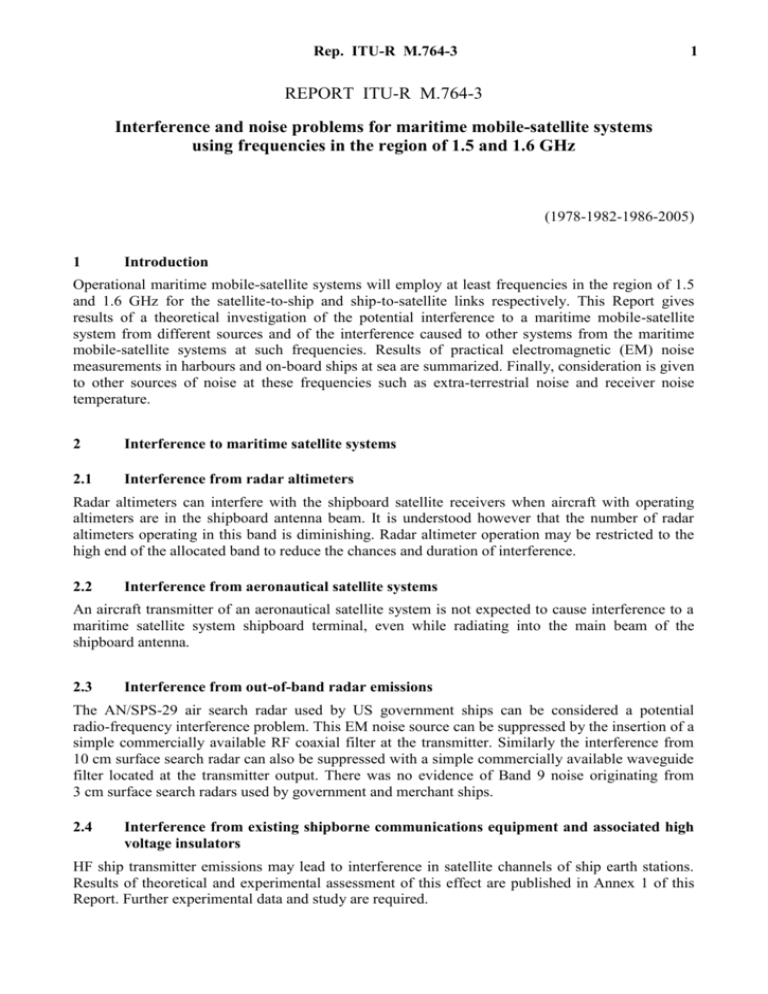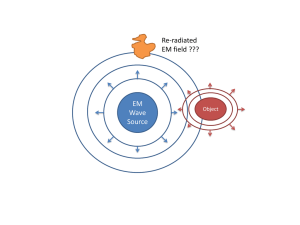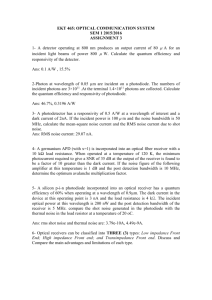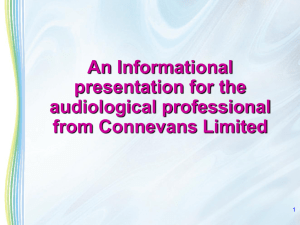Word for Windows
advertisement

Rep. ITU-R M.764-3 1 REPORT ITU-R M.764-3 Interference and noise problems for maritime mobile-satellite systems using frequencies in the region of 1.5 and 1.6 GHz (1978-1982-1986-2005) 1 Introduction Operational maritime mobile-satellite systems will employ at least frequencies in the region of 1.5 and 1.6 GHz for the satellite-to-ship and ship-to-satellite links respectively. This Report gives results of a theoretical investigation of the potential interference to a maritime mobile-satellite system from different sources and of the interference caused to other systems from the maritime mobile-satellite systems at such frequencies. Results of practical electromagnetic (EM) noise measurements in harbours and on-board ships at sea are summarized. Finally, consideration is given to other sources of noise at these frequencies such as extra-terrestrial noise and receiver noise temperature. 2 Interference to maritime satellite systems 2.1 Interference from radar altimeters Radar altimeters can interfere with the shipboard satellite receivers when aircraft with operating altimeters are in the shipboard antenna beam. It is understood however that the number of radar altimeters operating in this band is diminishing. Radar altimeter operation may be restricted to the high end of the allocated band to reduce the chances and duration of interference. 2.2 Interference from aeronautical satellite systems An aircraft transmitter of an aeronautical satellite system is not expected to cause interference to a maritime satellite system shipboard terminal, even while radiating into the main beam of the shipboard antenna. 2.3 Interference from out-of-band radar emissions The AN/SPS-29 air search radar used by US government ships can be considered a potential radio-frequency interference problem. This EM noise source can be suppressed by the insertion of a simple commercially available RF coaxial filter at the transmitter. Similarly the interference from 10 cm surface search radar can also be suppressed with a simple commercially available waveguide filter located at the transmitter output. There was no evidence of Band 9 noise originating from 3 cm surface search radars used by government and merchant ships. 2.4 Interference from existing shipborne communications equipment and associated high voltage insulators HF ship transmitter emissions may lead to interference in satellite channels of ship earth stations. Results of theoretical and experimental assessment of this effect are published in Annex 1 of this Report. Further experimental data and study are required. 2 Rep. ITU-R M.764-3 3 Potential interference from shipboard maritime satellite transmitters 3.1 Interference to aeronautical satellite systems One study has shown that interference from a shipboard transmitter of a maritime satellite system may occur only when the aircraft satellite receiver is within 4 nm of the ship and is within the main beam of the maritime satellite transmitter. 3.2 Interference to collision avoidance systems Spurious emissions from shipboard transmitters are potentially capable of interference to experimental collision avoidance systems. Limits on spurious emission should be established to eliminate insofar as practicable the source of interference. 3.3 Out-of-band interference to other radiocommunication services Satellite ship terminal transmitters may generate intermodulation, harmonic and other forms of spurious emissions which could cause harmful interference to other services operating above, between and below the 1.5 and 1.6 GHz maritime mobile satellite service bands. Limits on spurious emissions from satellite ship terminals should be determined which would eliminate insofar as practicable such interference. Studies on the values of limits should recognize practical equipment limitations. 3.4 In-band interference to the fixed service In accordance with the provisions of No. 5.359 of the Radio Regulations, the band 1 540 to 1 660 MHz is also allocated to the fixed service to certain Administrations in Regions 1 and 3. The potential interference from shipborne transmitters to the fixed service is under study (see Report ITU-R M.917, Annex I). 4 Electromagnetic compatibility An in-harbour and at-sea electromagnetic compatibility survey was made on board the American Alliance for a maritime satellite shipboard terminal operating in the 1 500 to 1 600 MHz band. 4.1 Field strength Measurements of field strength 1 m from the radar transmitter cabinets in the storage room showed that the cabinet radiation was not excessive. Field-strength measurements at the above deck locations showed levels that were either equivalent to or less than the levels measured in the storage room. Radar interference to the shipboard terminal was influenced by the relative location of the antennas. On the American Alliance, the separation between the maritime satellite antenna and the radar Band 9 antenna was 9.2 m, and for the Band 10 antenna it was 7.4 m. Closer spacing might justify the requirement for an additional low pass filter. 4.2 Interference to radars The test for shipboard satellite terminal interference to the Band 9 and Band 10 radars as installed on the American Alliance showed that this should not be a problem with 15 W power from the shipboard satellite transmitter. One 1.2 m (4 ft) diameter parabolic dish reflector, containing a righthand circular polarization feed, was used. The antenna gain was 24 dB at 1 559 MHz. Rep. ITU-R M.764-3 5 3 Extra-terrestrial noise Table 1 summarizes the effects of extra-terrestrial radio noise sources on a system at 1 500 MHz. TABLE 1 Extra-terrestrial radio source characteristics at 1 500 MHz Sun Moon Jupiter Casseopia Galactic centre Source size (steradians) 1.35 × 10–4 1.07 × 10–4 Point source Point source 1.9 × 10–3 (2.6 × 1.4 o) Power flux-density (W/(m2 · Hz)) 9.3 ×10–21 – – 2.2 × 10–23 Apparent temperature (K) 105 250 2 × 103 – 162 Antenna temperature (K) 20 dB antenna gain 107 0.21 <1 0.24 15 10 dB antenna gain 11 2.1 × 10–2 <10–1 2.4 × 10–2 7 3 dB antenna gain 2 2.1 × 10–3 <2 × 10–2 4.8 × 10–3 2 (estimated) Source 6 Atmospheric noise from absorption An absorbent medium, such as oxygen and water vapour in the atmosphere, emits thermal noise that can be described in terms of apparent sky temperature. At 1 600 MHz the temperature varies from 80 K to 2 K between elevation angles from 0o to 90o. At a 10 o elevation angle the sky temperature is about 10 K. 7 Noise of satellite ship terminal receiver The noise temperature of a satellite ship terminal receiver will depend mainly on the type of preamplifier stage and the feeder loss between the antenna and pre-amplifier. Typically the pre-amplifier would be mounted immediately behind the antenna to minimize feeder loss. In such a configuration a transistor pre-amplifier can provide a receiver noise temperature of the order of 225 K and an uncooled parametric amplifier of the order of 55 K. 8 Man-made noise Data has been recorded in harbour and at sea for approximately ten different classes of ships. All of the significant electromagnetic noise sources of Band 9 (1 535 to 1 660 MHz) which were measured were determined to be broadband in character relative to the link bandwidths contemplated for future maritime mobile-satellite system design. The broadband noise was intermittent and generally having a duration much shorter than a typical message element envisaged for a maritime satellite system. 4 Rep. ITU-R M.764-3 The predominant sources of serious electromagnetic noise around 1-5 GHz were found to be associated with electrical equipment operating intermittently in ports or in close proximity. This noise is generally broadband in character. A high percentage of these intermittent sources originated as broadband impulsive noise from ignition circuits associated with dockside and shipboard unloading apparatus. The same noise category was frequently evident for automobiles and trucks on highways and bridges adjacent to harbours, ports and canals. Also evident at ports is a component of city ambient noise which varies in amplitude from port to port, and also depends upon the time of the day. This noise varies in magnitude by 20 dB depending on whether it is measured on a normal working day or on weekends and holidays, when it is lower in magnitude. Occasionally evident while near or in port were radio-frequency interference noise power density levels 20 to 30 dB above the ambient receiver noise power density level far a 3 dB noise figure receiver. This increase in apparent ambient noise level may seriously affect link thresholds. Beyond radio line-of-sight of any port, radio-frequency interference should not affect receiver sensitivity especially for new ships. 8.1 Interference from automobiles on an expressway The peak amplitude of the noise emanating from the Brooklyn Expressway with heavy traffic was recorded to be about –150 dB(mW/Hz) within the 1.5-1.6 GHz band. For this test, a 20 dB gain horn antenna was used, oriented in the direction of the noise source. Under certain operating conditions, man-made noise from automobile traffic may impair receiver sensitivity level. 8.2 Ship-yard Extremely high peak amplitudes of noise of –141 dB(mW/Hz) were recorded from the Boston Navy Yard which was in full operation at the time. This noise is a combination of city ambient noise and of broadband electromagnetic noise from industrial equipment. A 20 dB gain horn antenna was used, oriented in the direction of the noise source. Under certain operating conditions ship-yard noise may impair receiver sensitivity levels in the 1.5-1.6 GHz band. 8.3 Dockside noise Broadband impulsive noise, originating from combustion engine ignition circuits used with dockside unloading apparatus, was found to exist at all ports. The recorded peak amplitude of the noise at Narragansett Bay, five miles From Portsmouth, Rhode Island (United States of America), is about –137 dB(mW/Hz) within the maritime mobile-satellite receive band. Noise levels of –150 dB(mW/Hz) have been recorded from ships’ cranes. A 20 dB gain horn antenna was used oriented in the direction of the noise sources. Rep. ITU-R M.764-3 5 Annex 1 Effect of shipborne HF transmitter operation on ship earth stations 1 Theoretical aspects A criterion for identifying the extent to which the HF transmitter emissions can affect the ship earth station operation is the susceptibility threshold of the ship earth station receiver. The threshold of susceptibility is assumed to be receiver sensitivity level calculated for the corresponding frequencies, fSR, which are capable of producing spurious responses and may be represented by the following expression: f SR pf LO f IF BR q 2q (1) where: fLO: fIF: BR: p,q local oscillator frequency (MHz) first intermediate frequency (MHz) dB bandwidth at the first intermediate frequency (MHz) harmonic number of local oscillator and interfering signal, respectively (p,q = 0,1, 2…, etc.). The receiver spurious response susceptibility threshold at the receiver input, PR(fSR), can be expressed as: f PR ( f SR ) PR ( fOR ) I log SR J f OR (2) where: PR(fOR): fOR: I,J: receiver fundamental sensitivity (dBm) receiver fundamental frequency (MHz) constants for characterizing receiver off-tune rejection (in dB/decade and dB respectively). The interference signal power produced by HF transmitters emissions at ship earth station receiver input, P1(fSR), is determined for transmitter fundamental harmonics in accordance with the following equation: P1( f SR ) PT ( fOT ) Alog n B Lc (3) where: PR(fOT): n: A, B: L c: fundamental power (dBm) harmonic number of transmitter frequency (fOT) relative to receiver spurious response frequency (fSR), n= fSR/fOT constants for characterizing transmitter harmonic emission levels (in dB/decade and dB respectively) coupling loss (dB) including propagation, receiver antenna and transmitter antenna effects. 6 Rep. ITU-R M.764-3 In more detail, Lc can be expressed as: LC 10 log af 20 log 10 log 10 log 10 log G (, , ) 10 log f 4r (4) where: ηaf: λ: r: G (θ, φ, λ): ηf: β, γ: transfer constant of transmitter antenna feeder link wave length (for corresponding harmonic) (m) distance between SES antenna and HF transmit antenna (m) SES receiver antenna gain referred to azimuth, θ, and elevation, φ i receiver feeder efficiency constants for characterizing the effects of antenna polarization mismatch and of physical obstructions. Equations (1) and (2) were applied to calculate receiver susceptibility threshold for spurious response frequencies most close to HF transmitter operating frequencies. Initial data used in the calculation were as follows: fOR = 1 538 MHz fLO = 1 351 MHz fIF = 187 MHz PR(fOR) = –139 dBm BR = 8.5 MHz I = –20 dB/decade P =0 J = 80 dB. Results of the calculation are shown in Table II. TABLE 2 Spurious response susceptibility thresholds q fSR (MHz) PR(fSR) (dBm) 8 10 11 5 7 13.37 ± 0 53 18.70 ± 0.42 17.00 ± 0.39 37.00 ± 0.85 26.71 ± 0.61 –22.6 –20.7 –19.9 –26.7 –23.8 The spurious response frequencies as given in Table 2 are the first IF sub-harmonics of ship earth station receive system. Using equation (3), interference power of spurious response frequencies was calculated and compared with the obtained values of receiver susceptibility threshold. The calculation was performed for those HF transmitter frequencies, fOT , which are capable of producing interference at the receiver spurious response frequencies. It was assumed that PT(fOT) = 500 W, A = –70 dB/decade (see Note 1), B = –20 dB, and free-space loss over a distance of 10 m was used for Lc. NOTE 1 – The value of A in future calculations can be taken as –60 dB/decade without impairing the quality of reception. Results of the calculation are shown in Table 3. Rep. ITU-R M.764-3 7 TABLE 3 Spurious response interference power fOT (MHz) n P1( fSR) (dBm) P1(fSR)/PR(fSR) (dB) 4.670 ± 0.1062 6.2333 ± 0.1417 17.00 ± 0.3864 8.50 ± 0.1932 12.4666 ± 0.2833 13.3571 ± 0.3035 5 3 1 2 3 2 –27.0 –9.5 +24.7 +3.6 –15.5 –0.3 –4.4 +11.2 +44.6 +23.5 +11.2 +23.5 TABLE 4 Interference power at SES receiver fundamental frequency (P1(fOR)) fOT (MHz) n P1(fOR) (dBm) P1(fOR)/PR fOR) (dB) 6.2 to 13.2 248 to 124 –102 to 82 –11 to 9 The above interference values are for only the first sub-harmonics of the ship earth station IF. It should be noted that equations (2) and (3) do not take into account non-linearities in active receiver or transmitter components that can affect the relative susceptibility or emission levels for different harmonics. 2 Experimental results During the experimental period, (I + N)/N levels were measured to identify the effect of HF transmitter emissions. Interference was produced by the HF transmitter emissions at the frequencies selected within the band shown in Table 3. Noise levels and interference-plus-noise levels were determined for 20 kHz bandwidth in the first IF channel of the ship earth station. The ship earth station antenna was directed towards the HF transmit antenna located at 8.6 m distance. The transmitter was operating in A1A emission mode, the emitted power being 1.5 kW. Shown in Table 5 are results of processing of measured (I + N)/N values. TABLE 5 Mean (I+N)/N vs. HF transmitter operating frequencies fOT (MHz) (I+N)/N (dB) 4.68 6.23 8.35 12.51 13.2 16.75 0 20 18 23 17 16 The measured interference in Table 5 does not compare directly with the calculated interference in Table 3. Any inconsistency is due to a number of factors not taken into account in calculating Table 3 values, e.g. frequency dependent effects on Lc. The interference in the receive channel was narrow-band in nature, with its level dependent upon directing the ship earth station antenna towards HF transmit antenna. Throughout the experiment period, the effect of HF transmitter emissions on the quality of telephone and telex message reception was examined at fOT = 12.502 MHz which causes 8 Rep. ITU-R M.764-3 interference at the receive frequency 1 537.75 MHz (satellite channel). Values of (I + N)/(C + N) were determined. No troubles were experienced with reception of reference telex messages with (I + N)/(C + N) ≤ –1 dB. It should be noted that this ratio may reach 15 dB at low elevation angles. The quality of telephone (I + N)/(C + N) ~ 2 dB, message reception was judged to be satisfactory, with where: I: N: C: interference sign level noise wanted carrier signal level. Should the (I + N)/(C + N) value measured in the first IF channel be equal to or exceed 5 dB, the telephone channel was completely blocked due to the interference.






